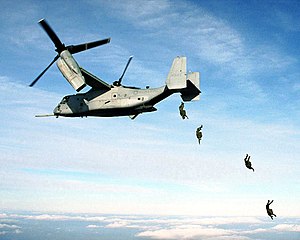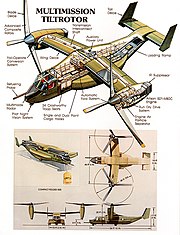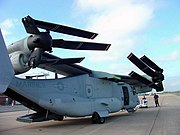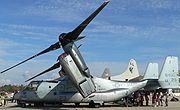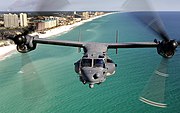V-22 Osprey
From Wikipedia, the free encyclopedia
| V-22 Osprey | |
|---|---|
| U.S. Marines jump from an Osprey. | |
| Role | V/STOL transport |
| National origin | United States |
| Manufacturer | Bell Helicopter Boeing Rotorcraft Systems |
| First flight | 19 March 1989 |
| Introduction | 8 December 2005 |
| Primary users | United States Marine Corps United States Air Force |
| Program cost | US$27 billion as of 2008[1] |
| Unit cost | US$68 million (CV-22 flyaway cost, 2008)[2] |
| Developed from | Bell XV-15 |
The V-22 Osprey is a multi-mission, military, tiltrotor aircraft with both a vertical takeoff and landing (VTOL) and short takeoff and landing (STOL) capability. It is designed to perform missions like a conventional helicopter with the long-range, high-speed cruise performance of a turboprop aircraft. The V-22 was developed and is manufactured by Bell Helicopter, in partnership with Boeing Rotorcraft Systems. The initial operators are the United States Marine Corps and Air Force.
Contents |
[edit] Development
[edit] Early development
The failure of Operation Eagle Claw in 1980 demonstrated to the United States military a need[3] for "a new type of aircraft, that could not only take off and land vertically but also could carry combat troops, and do so at speed."[4] The Department of Defense began the Joint-service Vertical take-off/landing Experimental (JVX) aircraft program in 1981, first under U.S. Army leadership, then the U.S. Navy/Marine Corps later took the lead.[5][6] The JVX combined requirements from the Marine Corps, Air Force, Army and Navy.[7][8] A request for proposals (RFP) was issued in December 1982 for JVX preliminary design work. Interest in the program was expressed by Aérospatiale, Bell Helicopter, Boeing Vertol, Grumman, Lockheed, and Westland. The DoD pushed for contractors to form teams. Bell partnered with Boeing Vertol. The Bell Boeing team submitted a proposal for a enlarged version of the Bell XV-15 prototype on 17 February 1983. This was the only proposal received.[9]
The JVX aircraft was designated "V-22 Osprey" on 15 January 1985. The USMC variant received the MV-22 designation and the Air Force variant received CV-22. This was reversed from normal procedure to prevent Marine Ospreys from having similar designations as aircraft carriers (CV).[10] Full-scale development of the V-22 tilt-rotor aircraft began in 1986.[1] The first V-22 was rolled out in May 1988. That same year the Army left the program citing a need to focus its budget on more immediate aviation programs.[11]
The V-22 was developed and is built jointly by Bell Helicopter, which manufactures and integrates the wing, nacelles, rotors, drive system, tail surfaces, and aft ramp, as well as integrates the Rolls-Royce engines, and Boeing Helicopters, which manufactures and integrates the fuselage, cockpit, avionics, and flight controls. Portions of the aircraft are manufactured in Philadelphia, Pennsylvania, Grand Prairie, Texas, and Fort Worth, Texas. Final assembly, flight testing, and delivery occurs in Amarillo, Texas. The joint development team is known as Bell Boeing.[12][13]
[edit] Flight testing and design changes
The first of six MV-22 prototypes first flew on 19 March 1989 in the helicopter mode and on 14 September 1989 as a fixed-wing plane. The third and fourth prototypes successfully completed the Osprey's first Sea Trials on the USS Wasp in December 1990. However, the fourth and fifth prototypes crashed in 1990-91. Flight tests were resumed in August 1993 after changes were incorporated in the prototypes.[1] From October 1992 until April 1993, Bell and Boeing redesigned the V-22 to reduce empty weight, simplify manufacture and reduce production costs. This redesigned version became the B-model.[14]
Flight testing of four full-scale development V-22s began in early 1997 when the first pre-production V-22 was delivered to the Naval Air Warfare Test Center, Naval Air Station Patuxent River, Maryland. The first EMD Flight took place on 5 February 1997. The first of four low-rate initial production aircraft, ordered on 28 April 1997, was delivered on 27 May 1999. Osprey number 10 completed the program's second Sea Trials, this time from the USS Saipan in January 1999.[1] During external load testing in April 1999, Boeing used a V-22 to lift and transport the M777 howitzer.[15] In 2000, Boeing announced that the V-22 would be fitted with a nose-mounted GAU-19 Gatling gun,[16] but the GAU-19 gun was later cancelled.[17]
In 2000, there were two further fatal crashes, killing a total of 19 Marines, and the production was again halted while the cause of these crashes was investigated and various parts were redesigned.[18]
The V-22 completed its final operational evaluation in June 2005.[19] The evaluation was deemed successful; events included long range deployments, high altitude, desert and shipboard operations. It was claimed that the problems identified in various accidents had been addressed by the V-22 program office.
On 28 September 2005, the Pentagon formally approved full-rate production for the V-22. The plan is to boost production from 11 a year to between 24 and 48 a year by 2012. Of the 458 total planned, 360 are for the Marine Corps, 48 for the Navy, and 50 for the Air Force at an average cost of $110 million per aircraft, including development costs.[1] The V-22 had an incremental flyaway cost of $70 million per aircraft in 2007,[2] but the Navy hopes to shave about $10 million off that cost after a five-year production contract starts in 2008.[20]
Israel has shown interest in the purchase of an undisclosed number of MV-22s, but an order has not been placed or approved.[21][22]
[edit] Controversy
The V-22's development process has been long and controversial. When the development budget, first projected at $2.5 billion in 1986, increased to $30 billion in 1988, then-Defense Secretary Dick Cheney tried to zero out its funding. He was eventually overruled by Congress.[18] As of 2008, $27 billion have been spent on the Osprey program and another $27.2 billion will be required before the program is completed.[23]
The V-22 squadron's former commander at Marine Corps Air Station New River, Lieutenant Colonel Odin Lieberman, was relieved of duty in 2001 after allegations that he instructed his unit that they needed to falsify maintenance records to make the plane appear more reliable.[1]
The aircraft is incapable of autorotation in the case of engine failure, a fact that led a director of the Pentagon's testing office in 2005 to say that if the Osprey loses power while flying like a helicopter below 1,600 feet (490 m), emergency landings "are not likely to be survivable". But Captain Justin (Moon) McKinney, a V-22 pilot, says that this will not be a problem, "We can turn it into a plane and glide it down, just like a C-130".[17] A complete loss of power would require the failure of both engines, as a drive shaft connects the nacelles through the wing; one engine can power both proprotors.[24] While vortex ring state contributed to a deadly V-22 accident, the aircraft is less susceptible to the condition than conventional helicopters and recovers faster.[3]
It was planned in 2000 to equip all V-22s with a nose-mounted gatling gun, to provide "the V-22 with a strong defensive firepower capability to greatly increase the aircraft's survivability in hostile actions."[16] The nose gun project was canceled however, leading to criticism by retired Marine Corps Commandant General James L. Jones, who is not satisfied with the current V-22 armament.[17]
With the first combat deployment of the MV-22 in October 2007, Time Magazine ran an article condemning the aircraft as unsafe, overpriced, and completely inadequate.[17] The Marine Corps, however, responded with the assertion that much of the article's data were dated, obsolete, inaccurate, and reflected expectations that ran too high for any new field of aircraft.[25]
[edit] Design
The Osprey is the world's first production tiltrotor aircraft, with one three-bladed proprotor, turboprop engine, and transmission nacelle mounted on each wingtip. It is classified as a powered lift aircraft by the Federal Aviation Administration.[26] For takeoff and landing, it typically operates as a helicopter with the nacelles vertical (rotors horizontal). Once airborne, the nacelles rotate forward 90° in as little as 12 seconds for horizontal flight, converting the V-22 to a more fuel-efficient, higher-speed turboprop airplane. STOL rolling-takeoff and landing capability is achieved by having the nacelles tilted forward up to 45°. For compact storage and transport, the V-22's wing rotates to align, front-to-back, with the fuselage. The proprotors can also fold in a sequence taking 90 seconds.[27]
The V-22 is equipped with a glass cockpit, which incorporates four Multi-Function Displays (MFDs) and one shared Central Display Unit (CDU), allowing the pilots to display a variety of images including: digimaps centered or decentered on current position, FLIR imagery, primary flight instruments, navigation (TACAN, VOR, ILS, GPS, INS), and system status. The flight director panel of the Cockpit Management System (CMS) allows for fully-coupled (aka: autopilot) functions which will take the aircraft from forward flight into a 50-foot hover with no pilot interaction other than programming the system.[28]
The V-22 is a fly-by-wire aircraft with triple-redundant flight control systems. With the nacelles pointing straight up in conversion mode at 90° the flight computers command the aircraft to fly like a helicopter, with cyclic forces being applied to a conventional swashplate at the rotor hub. With the nacelles in airplane mode (0°) the flaperons, rudder, and elevator fly the aircraft like an airplane. This is a gradual transition which occurs over the entire 96° range of the nacelles. The lower the nacelles, the greater effect of the airplane-mode control surfaces.

The Osprey is armed with one .308 in (7.62 mm) caliber machine gun pointing rearward that can be fired when the loading ramp is lowered. A GAU-19 three-barrel .50 in (12.7 mm) gatling gun mounted below the V-22's nose has also been studied for future upgrade.[17][29] BAE Systems is also developing a remotely operated turreted weapons system for the V-22.[30]
[edit] Operational history

Marine Corps crew training on the Osprey has been conducted by VMMT-204 since March 2000. On 3 June 2005, the Marine Corps helicopter squadron Marine Medium Helicopter 263 (HMM-263), stood down to begin the process of transitioning to the MV-22 Osprey. On 8 December 2005, Lieutenant General Amos, commander of the II MEF, accepted the delivery of the first fleet of MV-22s, delivered to HMM-263. The unit reactivated on 3 March 2006 as the first MV-22 squadron and was redesignated VMM-263. On 31 August 2006, VMM-162 (the former HMM-162) followed suit.
The Air Force's first operational CV-22 Osprey was delivered to the 58th Special Operations Wing (58th SOW) at Kirtland Air Force Base, New Mexico on 20 March 2006. This and subsequent aircraft will become part of the 58th SOW's fleet of aircraft used for training pilots and crew members for special operations use.[31] On 16 November 2006, the Air Force officially accepted the CV-22 in a ceremony conducted at Hurlburt Field, Florida.[32] The Air Force plans for its first CV-22 squadron, the 8th Special Operations Squadron, to become operational in early 2009.[3]
The Osprey entered operational service with the U.S. Marine Corps in 2007, in some cases replacing existing CH-46 Sea Knight squadrons.[33] On 23 March 2007, HMM-266 became Marine Medium Tiltrotor Squadron 266 (VMM-266) at Marine Corps Air Station New River, North Carolina.[34] On 13 April 2007, the U.S. Marine Corps announced that it would be sending ten V-22 aircraft to Iraq, the Osprey's first combat deployment. Marine Corps Commandant, General James Conway, indicated that over 150 Marines would accompany the Osprey set for September deployment to Al-Asad Airfield.[35][36]
On 10 July 2007 an MV-22 Osprey landed aboard the Royal Navy aircraft carrier, HMS Illustrious in the Atlantic Ocean. This marked the first time a V-22 had landed on any non-U.S. vessel.[37]
On 17 September 2007, ten MV-22Bs of VMM-263 left for Iraq aboard the USS Wasp. The decision to use a ship rather than use the Osprey's self-deployment capability was made because of concerns over icing during the North Atlantic portion of the trip, lack of available KC-130s for mid-air refueling, and the availability of the USS Wasp.[38]
The Osprey has provided support in Iraq, racking up some 2000 flight hours over three months with a mission capable availability rate of 68.1% as of late-January 2008.[39] They are primarily used in Iraq's western Anbar province for routine cargo and troop movements, and also for riskier "aero-scout" missions. General David Petraeus, the top U.S. military commander in Iraq, used one to fly around Iraq on Christmas Day 2007 to visit troops.[40] Then-presidential candidate Barack Obama also flew in Ospreys during his high profile 2008 tour of Iraq.[41]
The only major problem has been obtaining the necessary spare parts to maintain the aircraft.[42] The V-22 had flown 3,000 sorties totaling 5,200 hours in Iraq as of July 2008.[43]
USMC leadership expect to deploy MV-22s to Afghanistan in 2009.[42][44] The US Air Force deployed four CV-22s to an exercise in Africa in November 2008. The CV-22s flew nonstop from Hurlburt Field, Florida with in-flight refueling.[3]
[edit] Variants
- V-22A
- Pre-production full-scale development aircraft used for flight testing. These are unofficially considered A-variants after 1993 redesign.[45]
- HV-22
- The U.S. Navy considered an HV-22 to provide combat search and rescue, delivery and retrieval of special warfare teams along with fleet logistic support transport. However, it chose the MH-60S for this role in 19992.[46]
- SV-22
- The proposed anti-submarine warfare Navy variant. The Navy studied the SV-22 in the 1980s to replace S-3 and SH-2 aircraft.[47]
- MV-22B
- Basic U.S. Marine Corps transport; original requirement for 552 (now 360). The Marine Corps is the lead service in the development of the V-22 Osprey. The Marine Corps variant, the MV-22B, is an assault transport for troops, equipment and supplies, capable of operating from ships or from expeditionary airfields ashore. It is replacing the Marine Corps' CH-46E[34] and CH-53D.
- CV-22B
- Air Force variant for the U.S. Special Operations Command (USSOCOM). It will conduct long-range, special operations missions, and is equipped with extra fuel tanks and terrain-following radar.[48][49]
[edit] Operators
- United States Air Force
- 8th Special Operations Squadron (8 SOS) at Hurlburt Field, Florida
- 71st Special Operations Squadron (71 SOS) at Kirtland Air Force Base, New Mexico
- 20th Special Operations Squadron (20 SOS) at Cannon Air Force Base, New Mexico
- United States Marine Corps
[edit] Notable accidents
From 1991 to 2000 there were four significant crashes during testing:[18]
- On 11 June 1991, a mis-wired flight control system led to two minor injuries when the left nacelle struck the ground while the aircraft was hovering 15 feet in the air, causing it to bounce and catch fire.
- On 20 July 1992, a leaking gearbox led to a fire in the right nacelle, causing the aircraft to drop into the Potomac River in front of an audience of Congressmen and other government officials at Quantico, killing all seven on board and grounding the aircraft for 11 months.
- On 8 April 2000, a V-22 loaded with Marines to simulate a rescue, attempted to land at Marana Northwest Regional Airport in Arizona stalled due to its right rotor entered vortex ring state, rolled over, crashed, and exploded, killing all 19 on board.[50]
- On 11 December 2000, after a catastrophic hydraulic leak and subsequent software instrument failure, a V-22 fell 1,600 feet into a forest in Jacksonville, North Carolina, killing all four aboard.
Since becoming operational in 2006, the V-22 has had seven other notable, but minor incidents.
[edit] Specifications (MV-22B)
Data from Boeing Integrated Defense Systems,[51] Naval Air Systems Command,[52] US Air Force CV-22 fact sheet,[48] and Norton[53]
General characteristics
- Crew: two pilots
- Capacity: 24 troops (seated), 32 troops (floor loaded) or up to 15,000 lb of cargo
- Length: 57 ft 4 in (17.5 m)
- Rotor diameter: 38 ft 0 in (11.6 m)
- Wingspan: 45 ft 10 in (14 m)
- Width with rotors: 84 ft 7 in (25.8 m)
- Height: 22 ft 1 in/6.73 m; overall with nacelles vertical (17 ft 11 in/5.5 m; at top of tailfins)
- Disc area: 2,268 ft² (212 m²)
- Wing area: 301.4 ft² (28 m²)
- Empty weight: 33,140 lb (15,032 kg)
- Loaded weight: 47,500 lb (21,500 kg)
- Max takeoff weight: 60,500 lb (27,400 kg)
- Powerplant: 2× Rolls-Royce Allison T406/AE 1107C-Liberty turboshafts, 6,150 hp (4,590 kW) each
Performance
- Maximum speed: 305 knots (351 mph, 565 km/h) max operating at 15,000 ft[54]
- Cruise speed: 241 knots (277 mph, 446 km/h) at sea level
- Range: 879 nmi (1,011 mi, 1,627 km)
- Combat radius: 370 nmi (430 mi, 690 km)
- Ferry range: 2,417 nmi (2,781 mi, 4,476 km)
- Service ceiling: 26,000 ft (7,925 m)
- Rate of climb: 2,320 ft/min (11.8 m/s)
- Disc loading: 20.9 lb/ft² @ 47,500 lb GW (102.23 kg/m²)
- Power/mass: 0.259 hp/lb (427 W/kg)
[edit] Popular culture
Two CV-22s (of only three in the USAF inventory at the time)[55] were filmed in flight at Holloman Air Force Base, New Mexico, in May 2006 for the 2007 Transformers film.[56][57]
V-22s play prominent roles in several novels by Dale Brown, most particularly, Hammerheads which features an MV-22 on the cover.[58]
[edit] See also
- Elizabeth A. Okoreeh-Baah, USMC - first female to pilot a V-22 Osprey
Related development
Comparable aircraft
Related lists
[edit] References
- ^ a b c d e f Bolkcom, Christopher. RL31384 "V-22 Osprey Tilt-Rotor Aircraft". Congressional Research Service, 2 January 2009.
- ^ a b (PDF)FY 2009 Budget Estimates. United States Air Force. February 2008. pp. p. 133. http://www.saffm.hq.af.mil/shared/media/document/AFD-080204-081.pdf.
- ^ a b c d Kreisher, Otto. "Finally, the Osprey". Air Force magazine, February 2009.
- ^ Mackenzie, Richard (writer). (2008-04-07). Flight of the V-22 Osprey [Television production]. Mackenzie Productions for Military Channel. Retrieved on 2009-03-29.
- ^ Moyers, Al (Director of History and Research) (1 August 2007). "The Long Road: AFOTEC's Two-Plus Decades of V-22 Involvement". Headquarters Air Force Operational Test and Evaluation Center, United States Air Force. http://www.afotec.af.mil/news/story.asp?id=123057888.
- ^ "Chapter 9: Research, Development, and Acquisition". Department of the Army Historical Summary: FY 1982. Center of Military History (CMH), United States Army. 1988. ISSN 0092-7880. http://www.history.army.mil/books/DAHSUM/1982/ch09.htm.
- ^ Norton 2004, pp. 22-30.
- ^ "AIAA-83-2726, Bell-Boeing JVX Tilt Rotor Program", American Institute of Aeronautics and Astronautics (AIAA), 16-18 November 1983.
- ^ Norton 2004, pp. 31-33.
- ^ Norton 2004, p. 30.
- ^ Norton 2004, p. 35.
- ^ "V-22 Osprey: Overview". Integrated Defense Systems, Boeing. http://www.boeing.com/rotorcraft/military/v22/.
- ^ "The Bell-Boeing V-22". Military Aircraft. Bell Helicopter. 2007. http://www.bellhelicopter.com/en/aircraft/military/bellV-22.cfm.
- ^ Norton 2004, pp. 52-54.
- ^ Boeing (3 May 1999). V-22 Lifts 155 mm Howitzer. Press release. http://www.boeing.com/news/releases/1999/photorelease/photo_release_990503n2.htm.
- ^ a b "BB selects turreted gun system for V-22" (PDF). Osprey Facts (Boeing) 11 (7): 2. 14 September 2000. http://www.boeing.com/rotorcraft/military/v22/tilttimes/sep00.pdf.
- ^ a b c d e Thompson, Mark (26 September 2007). "V-22 Osprey: A Flying Shame". Time. http://www.time.com/time/nation/article/0,8599,1665835-1,00.html.
- ^ a b c Berler, Ron (July 2005). "Saving the Pentagon's Killer Chopper-Plane". Wired (CondéNet, Inc) 13 (7). http://www.wired.com/wired/archive/13.07/osprey.html?pg=1&topic=osprey. Retrieved on 8 February 2008.
- ^ Christie, Rebecca (31 May 2007). "DJ US Navy Expects Foreign Interest In V-22 To Ramp Up Next Year". Dow Jones Newswires. Naval Air Systems Command, United States Navy. http://www.navair.navy.mil/v22/index.cfm?fuseaction=news.detail&id=177.
- ^ Ben-David, Alon (25 January 2006). "Israel considers V-22 acquisition". Jane's Defence Weekly (Jane's Information Group). http://www.janes.com/defence/air_forces/news/jdw/jdw060125_1_n.shtml.
- ^ "Israel confirms interest in Bell Boeing V-22 tiltrotor". Flight International, 25 October 2007.
- ^ http://opencrs.com/document/RL31384
- ^ "V-22 Osprey: Propulsion System". GlobalSecurity.org. http://www.globalsecurity.org/military/systems/aircraft/v-22-propulsion.htm.
- ^ Hoellwarth, John (16 October 2007). "Leaders, experts slam Time article on Osprey". Marine Corps Times (Army Times Publishing Company). http://www.marinecorpstimes.com/news/2007/10/marine_osprey_071014/.
- ^ Croft, John (1 September 2007). "Tilters". Air & Space Magazine (Smithsonian Institute). http://www.airspacemag.com/military-aviation/osprey.html.
- ^ Currie, Major Tom P., Jr., USAF (April 1999) (PDF). The CV-22 'Osprey' and the Impact on Air Force Combat Search and Rescue. A Research Report Submitted to the Faculty, In Partial Fulfillment of the Graduation Requirements. Air Command and Staff College. http://www.fas.org/man/dod-101/sys/ac/docs/99-033.pdf.
- ^ Ringenbach, Daniel P. and Scott Brick (7 August 2005), "Hardware-in-the-loop testing for development and integration of the V-22 autopilot system" (PDF), AIAA Flight Simulation Technologies Conference Technical Papers (A95-39235 10-01), Baltimore, MD: AIAA, pp. 28–36, http://pdf.aiaa.org/preview/1995/PV1995_3385.pdf, retrieved on 3 August 2008
- ^ "Defensive Armament for the V-22 Selection, Integration, and Development" (PDF). Bell Helicopter and General Dynamics. http://www.dtic.mil/ndia/2002gun/depasqual.pdf.
- ^ BAE Systems (2 October 2007). BAE Systems Launches New V-22 Defensive Weapon System, Begins On-The-Move Testing. Press release. http://www.baesystems.com/Newsroom/NewsReleases/autoGen_10792205149.html.
- ^ "CV-22 delivered to Air Force". Air Force Link. Air Force Special Operations Command News Service (United States Air Force). 21 March 2006. http://www.af.mil/news/story.asp?id=123017805. Retrieved on 3 August 2008.
- ^ CV-22 arrival, Hulbert Field, United States Air Force, 20 April 2006. Retrieved 20 November 2006.
- ^ Carter, Chelsea J. (18 March 2008). "Miramar Base to Get Osprey Squadrons". USA Today. Associated Press). http://www.usatoday.com/news/nation/2008-03-18-316395978_x.htm.
- ^ a b Tabb, Cpl. Jonathan A. "VMM-266 third ‘Osprey’ squadron to stand-up". US Marine Corps Press Release, 23 March 2007.
- ^ Mount, Mike (14 April 2007). "Marines to deploy tilt-rotor aircraft to Iraq". CNN.com. http://www.cnn.com/2007/US/04/13/osprey/index.html. Retrieved on 19 April 2007.
- ^ "Controversial Osprey aircraft heading to Iraq; Marines bullish on hybrid helicopter-plane despite past accidents". MSNBC. 13 April 2007. http://www.msnbc.msn.com/id/18098457/. Retrieved on 3 August 2008.
- ^ Whittle, Richard (1 October 2007). "Military/Utility: Osprey Heads to Iraq". Rotor & Wing. http://www.aviationtoday.com/rw/issue/features/16153.html.
- ^ II MAW (FWD) PAO (23 January 2008). "MV-22 ‘Osprey’ brings new capabilities to the sandbox". U.S. Marine Corps. http://www.marines.mil/units/marforcom/iimef/2ndmardiv/Pages/JAN089.aspx.
- ^ Mount, Mike (8 February 2008). "Maligned aircraft finds redemption in Iraq, military says". CNN.com. http://edition.cnn.com/2008/TECH/science/02/08/osprey/index.html. Retrieved on 8 February 2008.
- ^ Hambling, David (31 July 2008). "Osprey's 'Excellent Photo Op'". Wired. http://blog.wired.com/defense/2008/07/httpwwwaviati-1.html. Retrieved on 6 August 2008.
- ^ a b Warwick, Graham (7 February 2008). "US Marine Corps says V-22 Osprey performing well in Iraq". Flightglobal. http://www.flightglobal.com/articles/2008/02/07/221396/picture-us-marine-corps-says-v-22-osprey-performing-well-in-iraq.html. Retrieved on 10 February 2008.
- ^ Hoyle, Craig (22 July 2008). "USMC eyes Afghan challenge for V-22 Osprey". Flight International. http://www.flightglobal.com/articles/2008/07/22/225803/farnborough-2008-usmc-eyes-afghan-challenge-for-v-22.html. Retrieved on 25 November 2008.
- ^ "V-22s Got Dirty in Anbar". Air Force magazine, Daily Report, 25 February 2009.
- ^ Norton 2004, p. 54.
- ^ "V-22 Osprey: HV-22 Navy Variant". GlobalSecurity.org. http://www.globalsecurity.org/military/systems/aircraft/hv-22.htm. Retrieved on 3 August 2008.
- ^ Norton 2004, pp. 28-30, 35, 48.
- ^ a b CV-22 Osprey. United States Air Force, November 2007. Retrieved 3 August 2008.
- ^ Norton 2004, pp. 71-72.
- ^ Gross, Kevin, Lieutenant Colonel U.S. Marine Corpsv; Tom Macdonald, MV-22 test pilot and Ray Dagenhart, MV-22 lead government engineer (2004-09). "Dispelling the Myth of the MV-22" (in English). Proceedings (The Naval Institute) (September 2004). http://www.military.com/NewContent/0,13190,NI_Myth_0904,00.html. Retrieved on 2009-04-09.
- ^ V-22 Osprey: Technical Specifications. Integrated Defense Systems, Boeing. Retrieved 25 November 2008.
- ^ V-22 Characteristics. Naval Air Systems Command. Retrieved 25 November 2008.
- ^ Norton 2004, pp. 110-111.
- ^ Norton 2004, p. 111.
- ^ Scalf, Russell (26 May 2006). "Ospreys in flight". United States Air Force. http://www.af.mil/news/story_media.asp?id=123021212.
- ^ Ponder, Arlan (5 June 2006). "Movie project transforms Holloman". 49th Fighter Wing Public Affairs, United States Air Force. http://www.af.mil/news/story.asp?id=123021221.
- ^ Simmons, Larry A. (3 July 2007). "'Transformers' put Airmen, aircraft on big screen". Air Force News Agency. United States Air Force. http://www.af.mil/news/story.asp?id=123059424.
- ^ Born, Dale (1991). Hammerheads. Berkley Books. ISBN 0425126455. http://books.google.com/books?id=w3QmgHta0jMC&q=Hammerheads+Dale+Brown&dq=Hammerheads+Dale+Brown&ei=yGssSc6uBozckASdrLGwBQ&pgis=1. Retrieved on 25 November 2008.
- Norton, Bill. Bell Boeing V-22 Osprey, Tiltrotor Tactical Transport. Midland Publishing, 2004. ISBN 1-85780-165-2.
[edit] External links
| Wikimedia Commons has media related to: V-22 Osprey |
- Official Boeing V-22 site
- Official Bell V-22 site
- V-22 Osprey web, and V-22 Osprey history on Navy.mil
- CV-22 fact sheet on USAF site
- V-22 page on GlobalSecurity.org
- V-22 Osprey page on airforce-technology.com
- After decades of tragedy, Osprey may be ready for combat, Otto Kreisher, San Diego Tribune, 15 July 2005
- A video footage of the 1991 Osprey crash with commentary
- Dispelling the Myths of the MV-22
- Osprey OK'd
- Onward and Upward
- "Flight of the Osprey", US Navy video of V-22 operations
- "Maritime Airborne Surveillance and Control (MASC) (UK MoD)". Navy Matters. http://navy-matters.beedall.com/masc.htm. Retrieved on 3 August 2008.
- Review of political forces that helped shape V-22 program
- The Osprey finally soars, CNN, 18 July 2006
- The Osprey On Future Weapons – Feb 2007
- "Marine Corps Helicopter Programs Stabilizing, Official Says", Defense Daily, May 28, 2008
|
||||||||
|
||||||||
|
|||||
|
||||||||||||||
